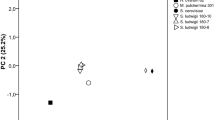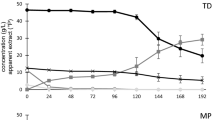Abstract
The use of non-Saccharomyces yeasts means a great source of biodiversity for the production of differentiated beer products. With this objective, five species of different genera have been selected in order to evaluate their influence on beer quality. Two different experiments were carried out with four non-Saccharomyces strains (Schizosaccharomyces pombe, Torulaspora delbrueckii, Saccharomycodes ludwigii and Lachancea thermotolerans) and Saccharomyces cerevisiae, as control. In the first experimental setup, the five strains were used to carry out the pure culture wort fermentation and to undertake bottle conditioning. In a second experimental setup, the wort was fermented with S. cerevisiae and the four non-Saccharomyces strains were used for bottle conditioning. Beers from the first experimental setup had low ethanol content due to the wort’s original gravity; T. delbrueckii produced a beer with the largest quantity of isoamyl acetate. In the second setup, the wort had higher original gravity; most of the fermentative volatiles were produced in larger amounts (1-propanol, isobutanol, 2-methyl-1-butanol, 3-methyl-1-butanol) with all tested strains. The differences observed in the volatiles production were more pronounced when the yeast strains were used for the fermentation and the bottle conditioning than whey they were used just for the bottle conditioning. The species S. pombe produced a significantly higher ethanol concentration (%v/v) in both experimental setups; these beers also obtained the highest scores for the sensory attributes foam consistency and foam persistence. Beers produced with T. delbrueckii and S. ludwigii had low ethanol content in both experimental designs, in pure culture fermentation and in bottle conditioning.



Similar content being viewed by others
References
Gómez-Corona C, Escalona-Buendía HB, García M, Chollet S, Valentin D (2016) Craft vs. industrial: habits, attitudes and motivations towards beer consumption in Mexico. Appetite 96:358–367
Verstrepen KJ, Derdelinckx G, Dufour JP, Winderickx J, Thevelein JM, Pretorius IS, Delvaux FR (2003) Flavor-active esters: adding fruitiness to beer. J Biosci Bioeng 96(2):110–118
Pires EJ, Teixeira JA, Brányik T, Vicente AA (2014) Yeast: the soul of beer’s aroma—a review of flavour-active esters and higher alcohols produced by the brewing yeast. Appl Microbiol Biotechnol 98(5):1937–1949
Bokulich NA, Bamforth CW (2013) The microbiology of malting and brewing. Microbiol Mol Biol Rev 77(2):157–172
Canonico L, Comitini F, Ciani M (2014) Dominance and influence of selected Saccharomyces cerevisiae strains on the analytical profile of craft beer refermentation. J Inst Brew 120(3):262–267
Capozzi Capozzi V, Makhoul S, Aprea E, Romano A, Cappellin L, Jimena SA, Biasioli F et al (2016) PTR-MS characterization of VOCs associated with commercial aromatic bakery yeasts of wine and beer origin. Molecules 21(4):483
Mascia I, Fadda C, Dostálek P, Karabín M, Zara G, Budroni M, Del Caro A (2015) Is it possible to create an innovative craft durum wheat beer with sourdough yeasts? A case study. J Inst Brew 121(2):283–286
Marongiu A, Zara G, Legras JL, Del Caro A, Mascia I, Fadda C, Budroni M (2015) Novel starters for old processes: use of Saccharomyces cerevisiae strains isolated from artisanal sourdough for craft beer production at a brewery scale. J Ind Microbiol Biotechnol 42(1):85–92
Callejo MJ, González C, Morata A (2017) Use of non-Saccharomyces yeasts in bottle fermentation of aged beers. In Brewing Technology. InTech
Yeo HQ, Liu SQ (2014) An overview of selected specialty beers: developments, challenges and prospects. Int J Food Sci Technol 49(7):1607–1618
Basso RF, Alcarde AR, Portugal CB (2016) Could non-Saccharomyces yeasts contribute on innovative brewing fermentations? Food Res Int 86:112–120
Petruzzi L, Rosaria Corbo M, Sinigaglia M, Bevilacqua A (2016) Brewer’s yeast in controlled and uncontrolled fermentations, with a focus on novel, nonconventional, and superior strains. Food Rev Int 32(4):341–363
Tataridis P, Kanelis A, Logotetis S, Nerancis E (2013) Use of non-Saccharomyces Torulaspora delbrueckii yeast strains in winemaking and brewing. Zbornik Matice srpske za prirodne nauke 124:415–426
Comitini F, Gobbi M, Domizio P, Romani C, Lencioni L, Mannazzu I, Ciani M (2011) Selected non-Saccharomyces wine yeasts in controlled multistarter fermentations with Saccharomyces cerevisiae. Food Microbiol 28:873–882. https://doi.org/10.1016/j.fm.2010.12.001
Gobbi M, Comitini F, Domizio P, Romani C, Lencioni L, Mannazzu I, Ciani M (2013) Lachancea thermotolerans and Saccharomyces cerevisiae in simultaneous and sequential co-fermentation: a strategy to enhance acidity and improve the overall quality of wine. Food Microbiol 33:271–281. https://doi.org/10.1016/j.fm.2012.10.004
Domizio P, House JF, Joseph CML, Bisson LF, Bamforth CW (2016) Lachancea thermotolerans as an alternative yeast for the production of beer. J Inst Brew 122(4):599–604
Loira I, Morata A, Comuzzo P, Callejo MJ, González C, Calderón F, Suárez-Lepe JA (2015) Use of Schizosaccharomyces pombe and Torulaspora delbrueckii strains in mixed and sequential fermentations to improve red wine sensory quality. Food Res Int 76:325–333
Morata A, Benito S, Loira I, Palomero F, González MC, Suárez-Lepe JA (2015) Formation of pyranoanthocyanins by Schizosaccharomyces pombe during the fermentation of red must. Food Res Int 76:325–333
Loira I, Vejarano R, Bañuelos MA, Morata A, Tesfaye W, Uthurry C, Villa A, Cintora I, Suárez-Lepe JA (2014) Influence of sequential fermentation with Torulaspora delbrueckii and Saccharomyces cerevisiae. on wine quality. LWT Food Sci Technol 59:915–922
Palomero F, Morata A, Benito S, Calderón F, Suárez-Lepe JA (2009) New genera of yeasts for over-lees aging of red wine. Food Chem 112:432–441
Morata A, Loira I, Tesfaye W, Bañuelos MA, González C, Suárez Lepe JA (2018) Lachancea thermotolerans applications in wine technology. Rev Ferment 4:53. https://doi.org/10.3390/fermentation4030053
ISO 6564 (1985) Sensory analysis. flavour profile methods. International Organization for Standardization, Geneva
ISO 4121 (2003) Sensory analysis. Evaluation of food products by methods using scales. International Organization for Standardization, Geneva
Brányik T, Silva D, Baszczynski M, Lehnert R (2012) Almeida e Silva. A review of methods of low alcohol and alcohol-free beer production. J Food Eng 108:493–506
Polshin E, Rudnitskaya A, Kirsanov D, Legin A, Saison D, Delvaux F, Delvaux F, Nicolaï B, Lammertyn J (2010) Electronic tongue as a screening tool for rapid analysis of beer. Talanta 81:88–94
Tan Y, Siebert KJ (2004) Quantitative structure–activity relationship modeling of alcohol, ester, aldehyde, and ketone flavor thresholds in beer from molecular features. J Agric Food Chem 52(10):3057–3064
Budroni M, Zara G, Ciani M, Comitini F (2017) Saccharomyces and non-saccharomyces starter yeasts. In Brewing Technology. InTech
Magalhães F, Vidgren V, Ruohonen L, Gibson B (2016) Maltose and maltotriose utilisation by group I strains of the hybrid lager yeast Saccharomyces pastorianus. FEMS Yeast Res 16(5):1–11
Meilgaard M (1975) Flavour chemistry of beer. Part 2. Flavour and threshold of 239 aroma volatiles. Tech Q Master Brew Assoc Am 12:151–168
Montanari L, Marconi O, Mayer H, Fantozzi P (2009) Production of alcohol-free beer. In: Preedy V (ed) Beer in health and disease prevention. Academic Press, Cambridge, pp 61–75
Alves-Araujo C, Pacheco A, Almeida MJ, Spencer-Martins I, Leao C, Sousa MJ (2007) Sugar utilization patterns and respiro-fermentative metabolism in the baker’s yeast Torulaspora delbrueckii. Microbiology 153:898–904
Canonico L, Agarbati A, Comitini F, Ciani M (2016) Torulaspora delbrueckii in the brewing process: a new approach to enhance bioflavour and to reduce ethanol content. Food Microbiol 56:45–51
Michel M, Kopecká J, Meier-Dörnberg T, Zarnkow M, Jacob F, Hutzler M (2016) Screening for new brewing yeasts in the non-Saccharomyces sector with Torulaspora delbrueckii as model. Yeast 33(4):129–144
Hughes PS, Baxter ED (2003) Cerveza. Calidad, higiene y características nutricionales. Ed. Acribia, Zaragoza
Escott C, Morata A, Loira I, Tesfaye W, Suarez-Lepe JA (2016) Characterization of polymeric pigments and pyranoanthocyanins formed in microfermentations of non-Saccharomyces yeasts. J Appl Microbiol 121(5):1346–1356
De Francesco G, Turchetti B, Sileoni V, Marconi O, Perretti G (2015) Screening of new strains of Saccharomycodes ludwigii and Zygosaccharomyces rouxii to produce low-alcohol beer. J Inst Brew 121(1):113–121
Suárez-Lepe JA, Palomero F, Benito S, Calderón F, Morata A (2012) Oenological versatility of Schizosaccharomyces spp. Eur Food Res Technol 235:375–383
Schmidt T, Kluba R (2002) Calidad de cerveza y metodología para catar. In: Jurado J, Russell I (eds) El cervecero en la práctica (427–456). Master Brewers Association of the Americas, St. Paul
Author information
Authors and Affiliations
Corresponding author
Ethics declarations
Conflict of interest
The authors declare that there are no conflicts of interest.
Compliance with ethics requirements
This article does not contain any studies with human or animal subjects.
Additional information
Publisher’s Note
Springer Nature remains neutral with regard to jurisdictional claims in published maps and institutional affiliations.
Rights and permissions
About this article
Cite this article
Callejo, M.J., García Navas, J.J., Alba, R. et al. Wort fermentation and beer conditioning with selected non-Saccharomyces yeasts in craft beers. Eur Food Res Technol 245, 1229–1238 (2019). https://doi.org/10.1007/s00217-019-03244-w
Received:
Revised:
Accepted:
Published:
Issue Date:
DOI: https://doi.org/10.1007/s00217-019-03244-w




